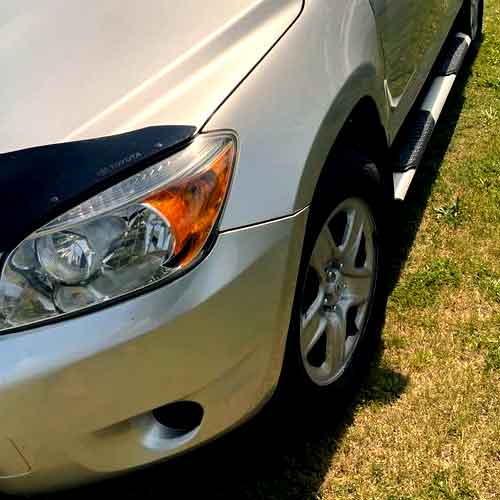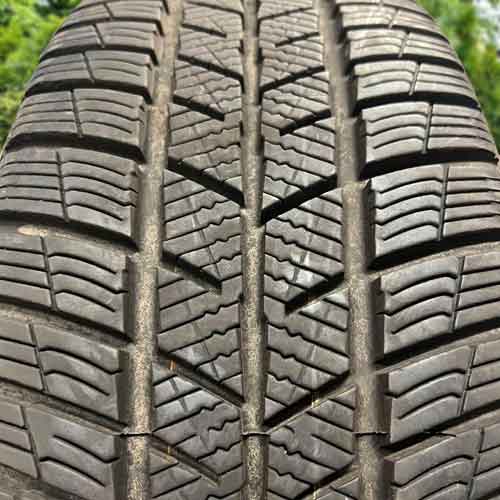In the books of winter tires, the Kleber Krisalp HP3 and the Barum Polaris 5, are each respected for their unique prowess in handling, tread life, and comfort, offer a range of options for various driving preferences. So let’s dig a little deep to find a better tire for you.

Table of Contents
Sizes Specs
The Kleber Krisalp HP3 (review) comes in 14 to 20 inches, (99 total sizes), in following specs.
- Speed ratings: T and H.
- Load ratings: SL and XL.
- Tread depth: 10/32″.
- Weight: 16 to 32 lbs.
- Tread warranty: None.
On the other side, the Barum Polaris 5 (review) comes in 74 total sizes, in 13 to 19 inches wheels, with following specs.
- Speed ratings: T, H and V.
- Load ratings: SL and XL.
- Tread depth: 9 to 10/32″.
- Weight: 15 to 26 lbs.
- Tread warranty: None.
Performance on Snow
The Kleber Krisalp HP3 seems to emerge as the marginally superior contender when considering performance in soft snow, due largely to the presence of numerous gaps and biters. These features act as effective snow traps, holding snow particles and promoting an improved snow-to-snow contact.

With each rotation of the tire, the trapped snow establishes the contact patch with the ground, resulting in enhanced traction.
But why its important?
Well, it’s the nature of snow to adhere more efficiently to itself than to rubber, facilitating this snow-to-snow connection.
The directional tread pattern of the Kleber Krisalp HP3 also creates a scooping effect, actively displacing snow and generating forward momentum.
Contrastingly, the Barum Polaris 5 doesn’t quite match up in these aspects.
With tread more on a symmetric side, it lacks the snow-trapping and scooping features found in the Kleber Krisalp HP3, leading to a slightly underwhelming snow performance.
A Look at Tread Life
Tread life is significantly affected by rolling resistance, which is determined by the tire’s weight and the rubber composition.
And here, the Kleber Krisalp HP3 is taking the back seat with its heavier structure, which imposes greater stress on the tread, as it rubs against the road.
Moreover, the tire’s softer compund isn’t helping that etither, allowing for the rubber to burn down more quckly in comparison.
Conversely, the Barum Polaris 5 enjoys the advantages of a lighter structure and more closely packed lugs, which results in reduced friction and slower wear when the tire meets the road.
Wet Traction
Wet traction is largely dictated by two crucial factors: the tread design and the rubber formulation. Both these components determine the tire’s grip on the road and resistance to hydroplaning—key aspects of wet performance.
Wet Grip
The Kleber Krisalp HP3’s triumphs in this arena, as the tire features more abundant biters and a more intricate siping design.
It’s tread gives out a more aggressive siping, having interlocking design, and those work alongside the notches to provide superior wet traction.
Actually, the whole game here is about having ample biting edges, that could grip in the relatively dried up surface, as the sipes suck up the water particles.
And yes, that is also helped by the tire’s grooves, though that has to do with hydorplaning.
Hydroplaning Resistance
Hydroplaning happens, when water forms a barrier between the tire tread and the road surface, causing the tire to get lifted up slightly, leading to a complete loss of traction.
This is a significant safety hazard, where the Kleber Krisalp HP3 seems to take the spotlight with its exceptional water (groove) channeling abilities.
It’s sweeping arms basically allow for better flaot speeds especially in curved aqua tests (meaning, out of both tires, it evacuates water out laterally, with more ease).
Though directionally, both tires are similar.
Dry Traction: Maintaining Grip on Dry Surfaces
Dry traction performance can be split into two categories: directional grip and handling. Let me start with the handling first.
Handling
The handling of a tire, which reflects its overall sideways traction, largely depends on its shoulder lugs.
But why is that?
Well, these shoulders/sidewalls get to meet up with the road better, as the tire turns, so “how well” they meet with the road is signficiant.
That’s why it makes sense why the Barum is taking the lead here, with a frimer rubber to road connection, allowing for faster handling times, and steering response.
Directional Grip
The Barum Polaris 5 pulls ahead in terms of directional grip, as well, and that is attributed to its wider, continuous-running central rubber area.
This basically allow for a better, and more uninterrupted contact between the rubber and the road results in shorter braking distances, (which is how this grip gets measured).
On the other hand, the Kleber Krisalp HP3, with its broader tread voids, naturally lacks here.
Evaluating Ride Comfort
The comfort provided by a tire is largely influenced by factors such as road noise and the capacity to absorb vibrations.
The Kleber Krisalp HP3 struggles with road noise, which originates from the collision of air particles against the walls of the tread voids, as its wider tread voids, allow air particles to hit around more freely, generating nosie.
Though the tire does okay in the secondar area of overall comfort, the shock absorption capabilities.
Thanks to its softer tread compound, this tire excels at cushioning shocks, ensuring a smoother ride overall. So pick your tire wisely here.
Fuel Economy
Tire fuel efficiency is fundamentally tied to tread design and tire weight, both of which affect rolling resistance.
And here, simply put, the Kleber Krisalp HP3, with its greater weight and larger tread voids, incurs increased lug flexing during cornering, braking, and acceleration, resulting in higher energy consumption.
In contrast, the Barum Polaris 5, designed with more streamlined, longitudinally aligned ribs, which don’t generate as much of the rolling resistance, relatively, leading to superior fuel efficiency.
Summing Up
In summary, both of these are premium winter tires, each excelling in their respective domains.
The Kleber Krisalp HP3 offers superior wet traction and soft snow performance, with its abundant sipes and tread voids.
However, the increased road noise due to wider grooves may compromise comfort levels.
Conversely, the Barum Polaris 5 outperforms in dry traction and fuel economy due to its continuous central rib and lighter weight, but lacks hydroplaning resistance.
Despite their respective strengths, the Kleber Krisalp HP3 suffers faster tread wear, while the Barum Polaris 5 ensures a smoother ride, illustrating that each tire is designed to meet specific driving conditions.